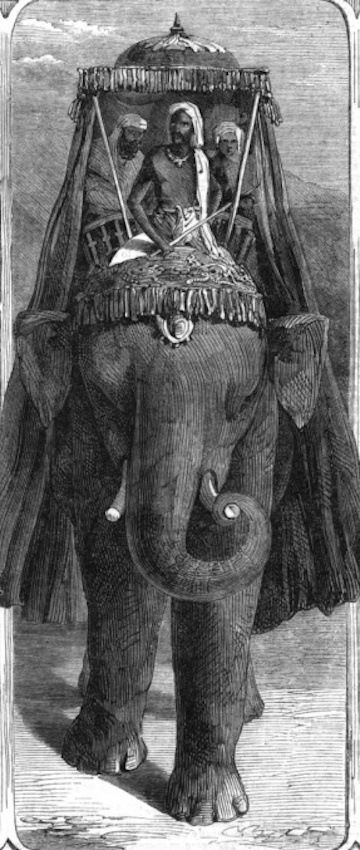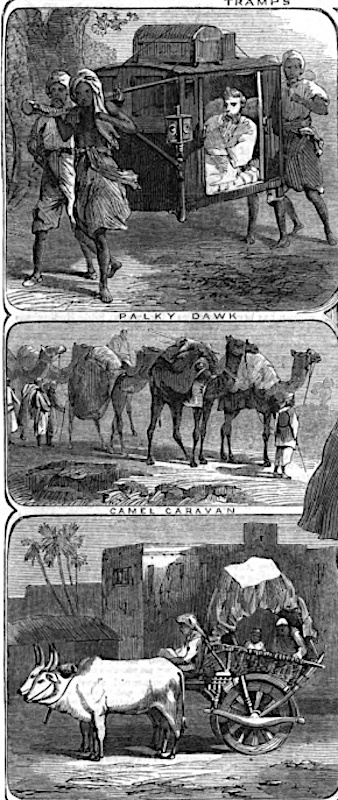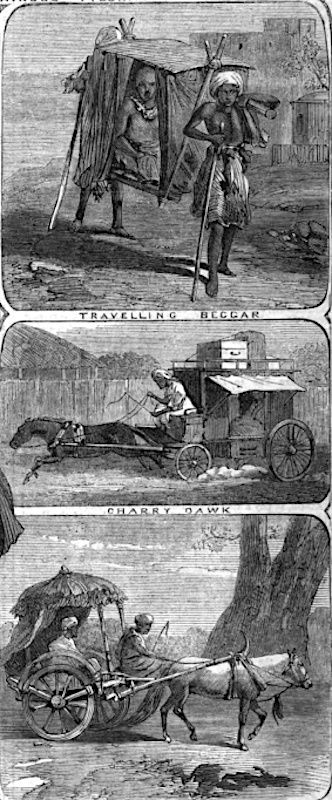

Modes of Travelling in India. From top left corner clockwise: Tramps; Hindoo Pilgrim; Travelling Beggar; Charry Gawk; An Ekha; The East Indian Railway; A Bhylie; Camel Caravan; Palky Gawk. Image from The Illustrated London News, 19 September 1863, p. 284. Pride of place is, of course, given to the elephant, which continues to be used on ceremonial occasions and for dragging heavy loads. Here, the mahout or elephant-driver conducts two passengers in the howdah behind him.

Left: "Tramps." Right: "A Hindoo Pilgrim." The former are probably itinerant nomadic or tribal people. There are still several hundred tribes which are nomadic in origin, if not in practice. The latter is a devout worshipper at a holy place, abasing himself in the presence or proximity of his goal, though he may adopt this mode of transport much earlier in his journey. He is not going as far as continually prostrating himself, but the idea is the same, i.e. not to touch the ground with the soles of the feet.


Left (top to bottom): "Palky Gawk"; "Camel Caravan"; "A Bhylie." Right (top to bottom): "Travelling Beggar": "Charry Gawk"; "An Ekha." These are mostly defined in their illustrations, except the "Travelling Beggar." A beggar was not someone begging for money, but a menial labourer: "a person pressed to carry a load, or do other work really or professedly for public service" (Yule and Burnell 80). The passenger here looks very much like a local big-wig.

"The East Indian Railway." By the end of the 1850s, the East Indian railway had 77 engines, 228 coaches and 848 freight wagons, all of this having been shipped from Britain (see "East Indian Railway"). However, this was not a great number, considering the immensity of the area to be covered, and people seem to be greeting this train as something of a novelty.
Illustration downloaded and excerpted, text and formatting, by Jacqueline Banerjee. [You may use these images without prior permission for any scholarly or educational purpose as long as you (1) credit the source and (2) link your document to this URL or cite the Victorian Web in a print document. Click on the images to enlarge them.]
Related material
Bibliography
"East Indian Railway" Grace's Guide: British Industrial History. Web. 20 April 2014.
The Illustrated London News, Vol. 43 (July-December 1863). 19 September 1863. Hathi Trust. Contributed by the University of Michigan. Web. 20 November 2019.
Yule, Henry, and A. C. Burnell. Hobson-Jobson: The Anglo-Indian Dictionary. 1886. Ware, Herts.: Wordsworth, 1996.
Created 20 November 2019